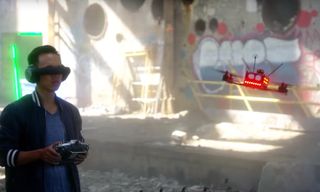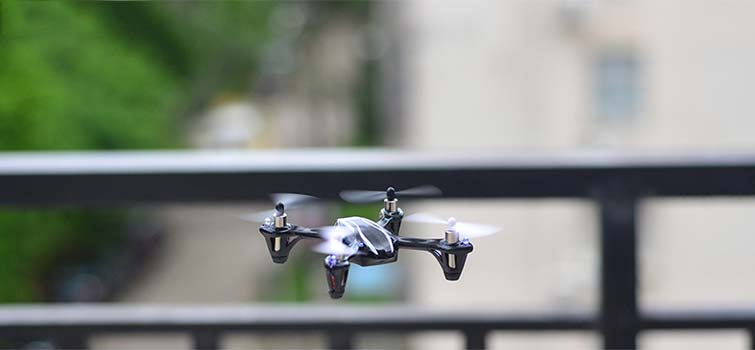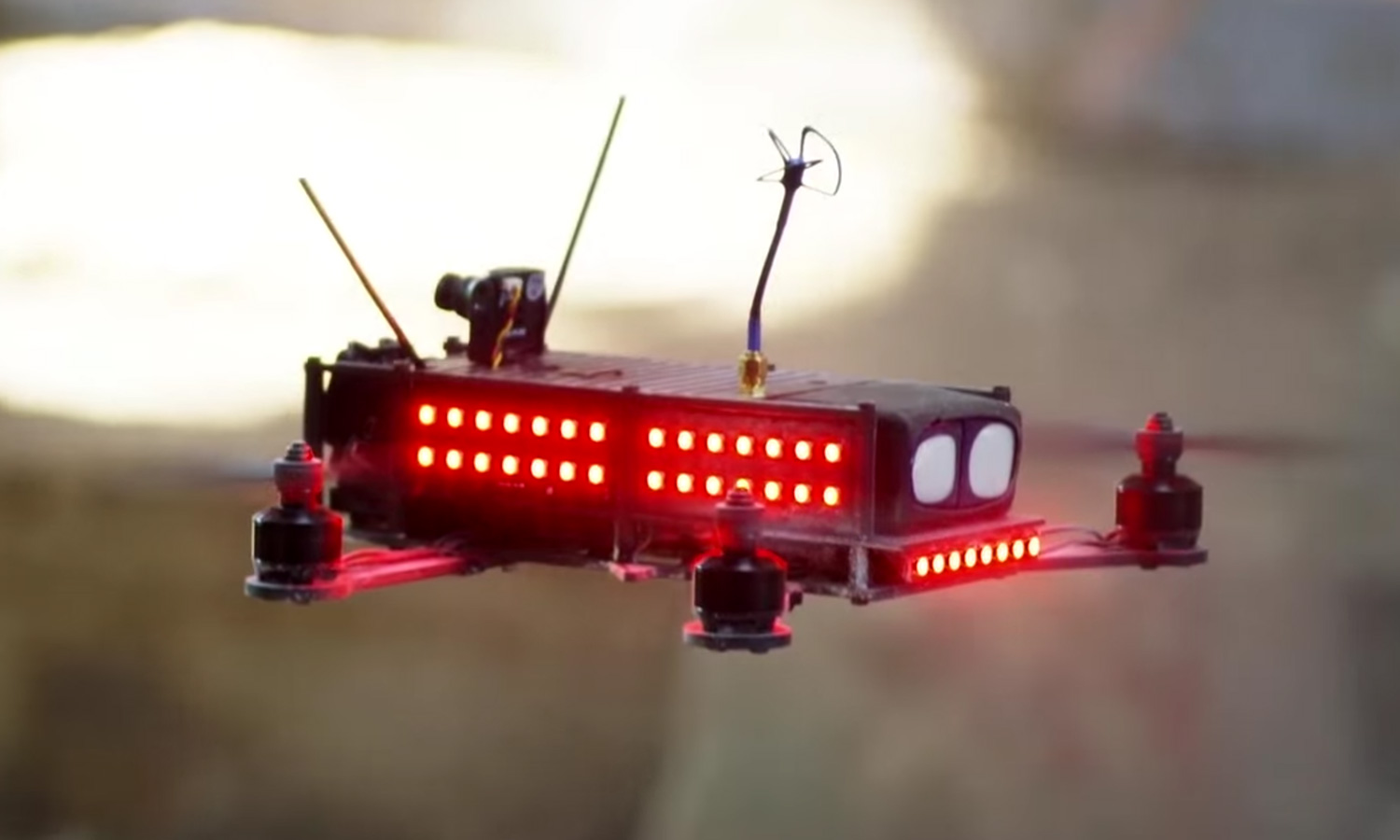How to Get Started with Drone Racing
How to Become Started with Drone Racing

Drone racing is one of the hottest, new sports out there. The spectacle of hot-shot pilots sending powerful drones racing around a track is a bang-up spectator sport, so information technology is no surprise that ESPN is planning to start broadcasting races soon. And it'southward easy to get into: all you demand is a drone and a few obstacles to fly through. Once you begin to strop your pilot skills, y'all can add the outset-person view (FPV) headset that the pros use to lookout man the action from the drone's betoken of view. Here's how to get into drone racing.
1. Find a local or online group
The best way to get a sense of taste of drone racing is to find a local racing group and dive right in. These groups are popping upwardly all over, and have regular meetings where the members get together to fly and prove off their skills. These meetings are a great identify to talk to enthusiasts about what racing involves.
Organizations like the Usa Drone Racing Association, MultiGP and the Academy of Model Aeronautics (AMA) take local fellow member groups that organize these meetings, and those who are interested in drone racing are usually welcome to attend. Some groups also offer classes to teach the basics of flying many types of aircraft, for both members and the public. The AMA charges $75 a year to bring together, and other groups may accuse a similar fee to support their work.
If you desire to find other like-minded drone racers online, the Reddit multicopter group and the DroneVibes forums are the nearly agile, and are a great place to meet others and discuss the hows and whys of drone racing.
More than: Drone Racing FAQ: Everything You Need to Know
2. Attend a race
There is nothing like the thrill of the race. The speed, the action, the crashes…. It all adds up to thrilling fun. Many local drone-racing groups organize race days on indoor or outdoor tracks, ranging from abased buildings and subterranean mines to simple tracks laid out in a local park.
These races are normally organized into classes for the different sizes and types of racing drones. How these classes are organized depends on the group behind them, but they are usually organized by weight, such as the 3S MultiGP class (less than 1.8 pounds) and the Mini class of the US Drone Racing Association (less than 0.vi pounds). For the serious flier, in that location is the open up course, where there are no limits on size and weight.
The aim of the race is to finish the largest number of laps in a specific amount of fourth dimension. The course is usually between 100 and 210 yards long, with a number of hoops or loops that the drones have to wing through. Miss a loop, and y'all have to fly back and get through it once more. The courses are laid out to exam the skills of the pilots, with precipitous turns and altitude changes between loops that require quick maneuvering and control.
3. Get a racing drone
One time you take attended a race and take a demand for speed, you can pick up a racing drone. Almost serious drone makers build their craft by mitt, picking from a huge range of components, looking for the fastest combination of motors, rotor blades and controllers.

But before you go that deep, you lot'll need to get your feet wet. The all-time place to get-go is with a simple, cheap drone similar the $120 Hubsan X4. This small, calorie-free quadcopter has a good amount of speed and control, and cheap parts for when y'all inevitably crash it. Information technology's the best way to get a experience for how drone racing works, and the skills needed to be a airplane pilot.
Most drone racers use a First-Person View (FPV) headset, which feeds the video from the drone photographic camera right into your optics. The X4 has a big screen on the controller, but the five.8-GHz video signal it sends tin can as well exist received by FPV headsets such as the $199 Fat Shark Teleporter.

In one case you have become familiar and comfortable with flying a cheap drone like the X4, it is time to pace up. A ready-to-fly drone similar the $349 Storm Racing Drone Blazon A is a expert place to start, as it comes pre-assembled, calibrated and ready to wing. This offers much more speed and maneuverability than the X4, with a much bigger battery, more powerful motors and a controller that tin handle the menstruation of free energy these motors need. This also includes a more sophisticated controller that tin can be adapted to your preferences, and useful features like a low-battery cablegram.
Subsequently that, the drone-racing world is wide open up. Y'all can gradually replace parts of the Storm with better, more expensive ones, or build your own drone from scratch with lighter, more powerful and more expensive components.
Some of the professional person racing leagues require the apply of a certain drone or components, though, so bear this in listen when edifice. Other leagues and competitions will supply the drones themselves to ensure a fair contest.
4. Practice
In one case you take your drone, you lot'll need to practice, practice, practice. In that location are 2 means to do this: on a test track or with a simulator.
The aim of drone racing is to navigate tight obstacles at speed, so many drone racers railroad train in places similar woods or buildings that offer plenty of obstacles. Come up with a simple course that y'all tin practice, navigating it at higher speeds until it becomes second nature. Don't forget to get out in different weather condition weather: not all races are held on clear, even so days, so you lot will need to be able to handle wind and rain.
Wherever you do piece of work on your skills, make sure it is abroad from people, as a runaway racing drone tin seriously injure someone. Many radio-control user groups will have flying fields that are a adept option, as they have already secured the appropriate permissions. At that place is a expert index of clubs and flying fields on RC Airplane Globe.
For those days when the weather doesn't let for outdoor drills, y'all can use your computer with a drone-racing simulator. There are a couple bachelor: FPV Freerider ($five) and Drone Racing ($ten). Both of these provide a practiced way to simulate flying on a number of tracks, and let you to connect your drone controller to the computer for more realistic flight. Both programs are a niggling rough around the edges, so you will need some patience to ready them upwardly and get practicing. But once setup, they offer simulated flights with realistic physics and drones on a wide range of tracks. They even simulate things similar the video fading out when the drone is a distance abroad, and the occasional stutters that a loss of signal can entail.
5. Race!
Finally, you are ready to race. When y'all are attending an organized race, don't forget to register in advance if required and read the rules. Some races will be for members only, while others may welcome all comers. All races will accept a safety briefing and equipment check before you race, then make sure your drone and other equipment is properly set up and ready to go.
Before each race, you lot will exist assigned a frequency to use, so double bank check that your equipment is set up to that frequency, and that yous are not interfering with other racers. Don't exercise or test your system when other races are going on, as even a slight blip on a frequency that is in use tin send a racer spiraling out of command. The frequency assignments are the key to a fair race, and messing with that will get you quickly thrown out or banned.
- Best Drones 2016
- Drone Buying Guide: Everything Y'all Need to Know
- What the FAA'due south Drone Rules Mean for Y'all
Source: https://www.tomsguide.com/us/how-to-start-drone-racing,review-3646.html
Posted by: martinnort1994.blogspot.com


0 Response to "How to Get Started with Drone Racing"
Post a Comment